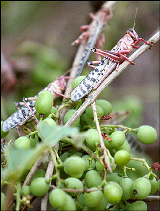Plague of locusts reaches Chad, heading for Darfur: UN official
By ALEXANDER G. HIGGINS, Associated Press Writer
GENEVA, Aug 11, 2004 (AP) — The plague of locusts sweeping across Africa has reached Chad and threatened to enter Sudan’s Darfur region, adding to concerns for millions suffering what aid workers call the world’s worst humanitarian crisis, a U.N. official said.

“The locusts have entered Chad because of winds, which aid workers fear will eventually take them into Darfur,” said Elizabeth Byrs, spokeswoman of the U.N. Office for the Coordination of Humanitarian Affairs.
The insects caused serious crop damage in Mauritania, Mali and Niger before crossing into western Chad, Byrs told The Associated Press on Tuesday.
She could not say if the swarms would continue their current path toward eastern Chad, where some 200,000 refugees from Darfur are living in makeshift camps. Chad is about 800 kilometers (500 miles) across.
Further east in Darfur, more than 2 million are in desperate need of food aid after more than 18 months of violence and looting has forced 1 million people to flee their homes, destroyed irrigation wells and prevented a year’s harvesting of crops.
Pro-government Arab militiamen have launched the attacks, leaving some 30,000 people dead, in a bid to drive black Africans, mainly farmers, from the region.
A major international campaign is being mounted to get food aid to the refugees in Chad, though the rainy season has limited the ability of trucks to reach camps on dirt roads.
Byrs said that Chad had appealed for US$7 million (A?5.7 million) to treat up to 250,000 hectares (617,750 acres) expected to be hard hit by the locusts, sub-Saharan Africa’s biggest plague of the insects in more than a decade.
The U.N. Food and Agriculture Organization said the insects were settling at a rate of 200,000 locusts per acre. Blankets of the insects have been covering houses, cars and roads.
The last comparable locust infestation, in 1987-89, cost more than a half-billion dollars to combat, U.N. officials say.
